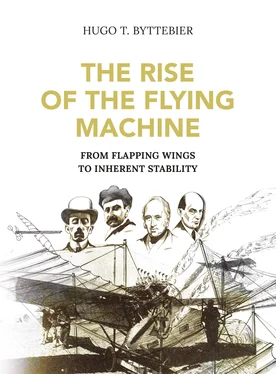Giovanni Borelli and Isaac Newton
Leonardo’s designs inspired none of his contemporaries and two more centuries were to elapse before the problems were again approached scientifically. In 1680 an important book was published posthumously. It was written by Giovanni Alphonso Borelli, a learned Neapolitan doctor who had devoted himself to studying all forms of animal locomotion, including an analysis of the flight of birds, and had been struck by the strength and size of the musculature that moved the birds’ wings.
As a result of these studies, Borelli, like Leonardo two centuries earlier, concluded that man would never be capable of flying with the use of his muscles. This time, however, the problems were not shelved as in Leonardo’s time because the second half of the 17th century saw a major development in western thought based on the study of the surrounding material world.
A few years after the publication of Borelli’s book, and inspired by it, the great English physicist Isaac Newton, took up the problems again and he very carefully studied the movements of elongated shapes through fluids and gases to try to obtain a universal formula governing these movements and the resistance they created.
Newton arrived at a very interesting conclusion, that the resistance of a surface moving through a fluid was dependent on the density of that fluid (moving through air is easier than through water). It was also dependent on the surface of the moving shape and on the square of its speed because great speeds create very great resistance and a great deal of power is needed to overcome them.
The most interesting conclusion Newton reached was that the reaction resulting from the resistance induced by the horizontal movement of a flat body through a fluid at a small angle of incidence was that the moving object was pushed upwards with a force dependent on its surface and the square of its speed.
Newton thus arrived at the formula for calculating the resistance as:
R=KdS V 2 sin2 θ .
He defined the resistance, R as a force acting in a direction perpendicular to the surface, and dependent on the density of the fluid (d), the square of the velocity of the incoming fluid stream (V2), the surface area (S), and the angle that the surface makes relative to the initial flow direction (called the angle of attack and represented by θ). K is a constant which could only be found by experimentation.
This formula, except for the square of sinus θ proved to be correct and indicates that the resistance that generates lift increases with the square of the speed, so that, given adequate power to overcome the resistance, any winged object can be made to fly. The emphasis is here on “adequate power” because this was the big hitch that kept the aeroplane enthusiasts from flying for nearly two more centuries.
In stating that the resistance of a moving wing was also dependent on the square of sinus θ. Newton made an error of far-reaching significance because it caused stagnation in aeronautical research, at least in France. Although Newton’s use of the term resistance to describe this force survived until the early twentieth century, it will be less confusing if we substitute it by the modern term reaction force.
In 1780, two French scholars, Condorcet and Monge, in a “rapport” to L’Académie des Sciences arrived at the same conclusions as Borelli whilst Coulomb at about the same time calculated that man, in order to fly, would need wings with a surface area of 12,000 square feet.
Early in the nineteenth century, a group of scientists, among whom were Gay-Lussac, Flourens and Navier, studied Newton’s formula and adapted it to bird flight. Navier, who made the calculations, came to the startling conclusion that seventeen swallows in flight developed a force equivalent to 1 hp.
There were opposing voices, from Bobinet and others, but Navier’s calculations were accepted and presented to L’Académie des Sciences in 1829. So, for about 40 years this brought interest in dynamic flight in France to a standstill.
The Search for Power
At the time when Newton was making his observations, the search for mechanical sources of energy was in full flight. During the last quarter of the 17th century, ideas and proposals were beginning to be formed around the use of heat produced by chemical reactions for use in motors. This started a series of discoveries, which eventually resulted in supplanting animal musclepower as man’s principal source of energy, and thereby helped to abolish slavery as a happy side-effect.
The first to convert these ideas into practice was the great Dutch scientist Christian Huyghens. In 1673 he presented an internal combustion engine that burned minute quantities of gunpowder to the French Academy of Science.
Huyghens’ machine was used in Paris for pumping water. His young assistant, Denis Papin, later built an identical engine for Charles Landgrave of Hesse. But Papin hit upon a more practical way of raising pressure inside the working cylinder by using steam.
Although Papin’s engines worked on the model devised by Huyghens by creating a vacuum under a piston, the use of steam made the control of combustion much easier and this marked the beginnings of the steam engine, which was then rapidly developed, becoming the first type of engine to be used as a power source for aircraft.
Papin was not able to pursue his discovery to any practical end and it was again in Britain that the steam engine was perfected through the efforts of James Watt, who turned it into a powerplant of practical use. At the beginning of the nineteenth century Richard Trevithick had designed and built machines which worked with the direct pressure of steam against a piston in order to obtain much higher powers than could be obtained by the system devised by Watt which still worked with atmospheric pressure.
At the same time one of the most extraordinary minds that ever studied the problems of aviation was active and began to write down his observations and findings. This was Sir George Cayley, a country squire who has been deservedly dubbed “father of aviation”.
Sir George Cayley
Cayley worked and wrote down his observations at a time when those interested in aviation had shifted their ideals and become aware of the possibilities of an artefact they had long been aware of, a plaything they had looked at without seeing, as the French enthusiast de La Landelle aptly put it.
It suddenly dawned on a few privileged minds that the kite, the plaything referred to, was in fact a flying body governed by the same laws of aerodynamics that applied to birds, those same laws that had been formulated by Newton. The kite, it was now believed, would be able to lift man into the air in a more rational manner than could be achieved by trying to imitate birds, so the kite would become a mechanical bird.
It is generally believed that the kite was invented by the Chinese a few centuries before the Christian era, but another contender for the title of inventor is the Greek philosopher Archytas of Tarent, who lived in the 4th century BC.
When speculating about the kite’s origins, the theory that it could have been discovered accidentally by observing runaway sails or hats or something similar holds little ground because it overlooks the fact that a kite can only rise when it is firmly attached to the ground. It would be more logical to visualize some kind of sail tugging at the hand of someone who held it as tightly as he could.
Kites began to be regarded as subject to the laws of aerodynamics during the 18th century, and in 1756 the German mathematician Euler wrote: “The kite, this child’s toy, despised by the scholars, could nevertheless lead to the most profound reflections”.
Читать дальше












